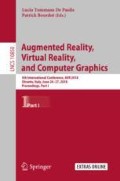Abstract
This article describes the development of games within virtual reality environments oriented to early childhood education children between 3 and 5 years old. These games are developed according to the Cone of Learning and have been developed with a Unity 3D graphic engine. They are very attractive and allow children’s learning through playing. They also stimulate the skills and abilities required to be developed and strengthened during this learning stage. The proposed games allow the teacher to select several difficulty levels on each game in order to stimulate the child to accomplish more complex tasks during this initial stage. At the end, the areas intended to be covered are presented according to the goals set.
The original version of this chapter was revised: The names of two authors and an e-mail address were corrected. The correction to this chapter is available at https://doi.org/10.1007/978-3-319-95270-3_44
Access this chapter
Tax calculation will be finalised at checkout
Purchases are for personal use only
Change history
19 September 2018
A correction has been published.
References
J., Palacios, C.E.: Early childhood (0–6 years) and its future. Organization of Ibero-American States for Education, Science and Culture (2009)
Gálvez, I.: La educación inicial en el ámbito internacional: Situación y perspectivas en Ibe-roamérica y en Europa. Revista Iberoamericana de educación, nº 22 (2000)
Cózar Gutiérrez, R., De Moya Martínez, M.V., Hernández Bravo, J.A., Hernández Bravo, J.R.: Tecnologías emergentes para la enseñanza de las Ciencias Sociales. Una experiencia con el uso de Realidad Aumentada en la formación inicial de maestros. Digit. Educ. Rev. 27, 138–153 (2015)
Dias, V., Gil, H., Gonçalves, T.: The Multimedia Interactive Whiteboard (MIW) in a supervised teaching practice in basic education. In: International Symposium on Computers in Education (SIIE 2015), Portugal, pp. 10–14. IEEE (2015)
Huang, H.M., Rauch, U., Liaw, S.S.S.: Investigar las actitudes de los alumnos hacia los entornos de aprendizaje de realidad virtual: Basado en un enfoque constructivista. Comput. Educ. 55(3), 1171–1182 (2010). https://doi.org/10.1016/j.compedu.2010.05.014
Ortiz, J.S., Sánchez, J.S., Velasco, P.M., Sánchez, C.R., Quevedo, W.X., Zambrano, V.D., Arteaga, O., Andaluz, V.H.: Teaching-learning process through VR applied to automotive engineering. In: Proceedings of the 2017 9th International Conference on Education Technology and Computers, pp. 36–40. ACM, December 2017
Hamada, S.: Education and knowledge based Augmented Reality (AR). In: Shaalan, K., Hassanien, A.E., Tolba, F. (eds.) Intelligent Natural Language Processing: Trends and Applications. SCI, vol. 740, pp. 741–759. Springer, Cham (2018). https://doi.org/10.1007/978-3-319-67056-0_34
Quevedo, W.X., et al.: Virtual reality system for training in automotive mechanics. In: De Paolis, L.T., Bourdot, P., Mongelli, A. (eds.) AVR 2017. LNCS, vol. 10324, pp. 185–198. Springer, Cham (2017). https://doi.org/10.1007/978-3-319-60922-5_14
Pantelidis, V.S.: Razones para utilizar la realidad virtual en los cursos de educación y formación y un modelo para determinar cuándo utilizar la realidad virtual. Themes Sci. Technol. Educ. 2(1–2), 59–70 (2010)
Hui-Min, Z.: Constructivism teaching mode of college English based on Multimedia. In: IEEE Taller sobre Investigación y Tecnología Avanzadas en Aplicaciones Industriales (WARTIA), pp. 147–149 (2014)
McLellan, H.: Realidad virtual e inteligencias múltiples: Potenciales para la educación superior. J. Comput. High. Educ. 5(2), 33–66 (1994)
Suárez, J., Maiz, F., Meza, M.: Inteligências múltiplas: Uma inovação pedagógica para promo-ver o processo ensino-aprendizagem. Investigación y Postgrado, nº 25, pp. 81–94 (2010)
Sánchez, J.J.M., Ruiz, A.B.M., Olmos, A.: Augmented Reality (AR). Resources and proposals for educational innovation. Inter-Univ. Electron. J. Teach. Train. 20(2), 183–204 (2017)
Acknowledgements
The authors would like to thanks to the Corporación Ecuatoriana para el Desarrollo de la Investigación y Academia – CEDIA for the financing given to research, development, and innovation, through the CEPRA projects, especially the project CEPRA-XI-2017-06; Control Coordinado Multi-operador aplicado a un robot Manipulador Aéreo; also to Universidad de las Fuerzas Armadas ESPE, Universidad Técnica de Ambato, Escuela Superior Politécnica de Chimborazo, and Universidad Nacional de Chimborazo, and Grupo de Investigación en Automatización, Robótica y Sistemas Inteligentes, GI-ARSI, for the support to develop this work.
Author information
Authors and Affiliations
Corresponding authors
Editor information
Editors and Affiliations
Rights and permissions
Copyright information
© 2018 Springer International Publishing AG, part of Springer Nature
About this paper
Cite this paper
Sánchez, J.S. et al. (2018). Virtual Environments to Stimulate Skills in the Early Childhood Education Stage. In: De Paolis, L., Bourdot, P. (eds) Augmented Reality, Virtual Reality, and Computer Graphics. AVR 2018. Lecture Notes in Computer Science(), vol 10850. Springer, Cham. https://doi.org/10.1007/978-3-319-95270-3_24
Download citation
DOI: https://doi.org/10.1007/978-3-319-95270-3_24
Published:
Publisher Name: Springer, Cham
Print ISBN: 978-3-319-95269-7
Online ISBN: 978-3-319-95270-3
eBook Packages: Computer ScienceComputer Science (R0)

